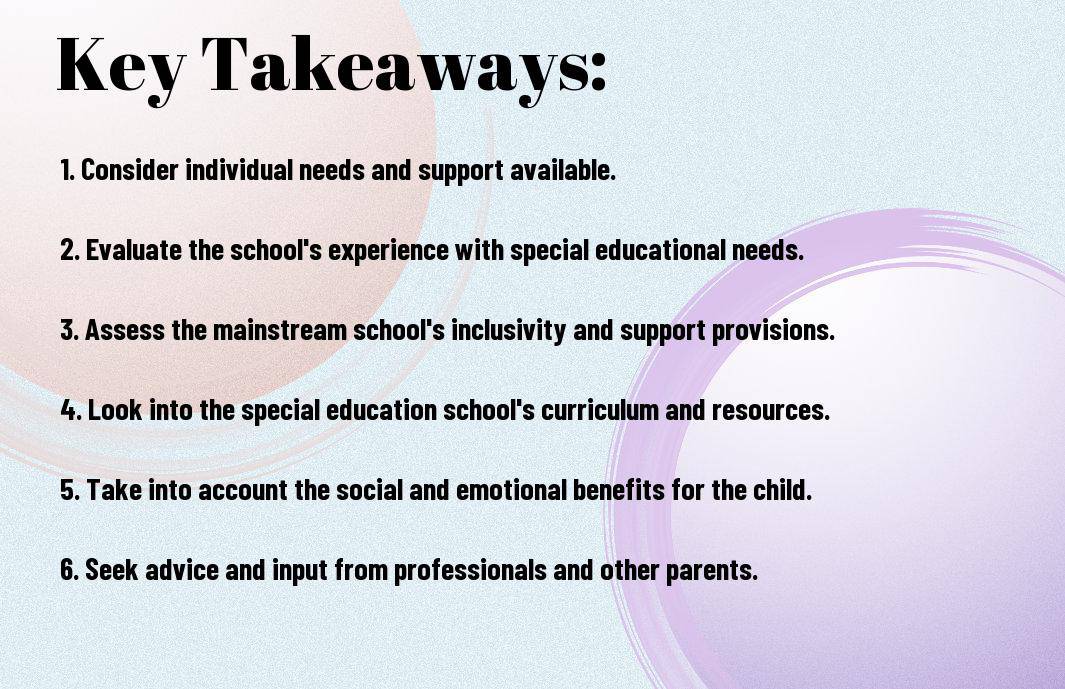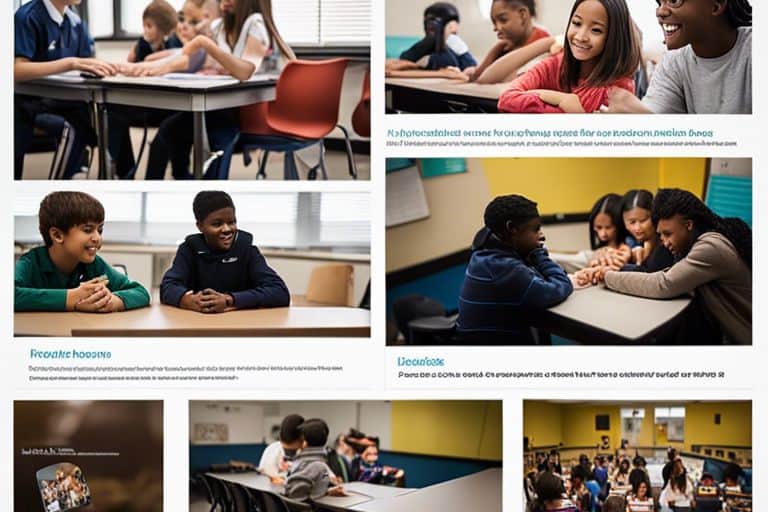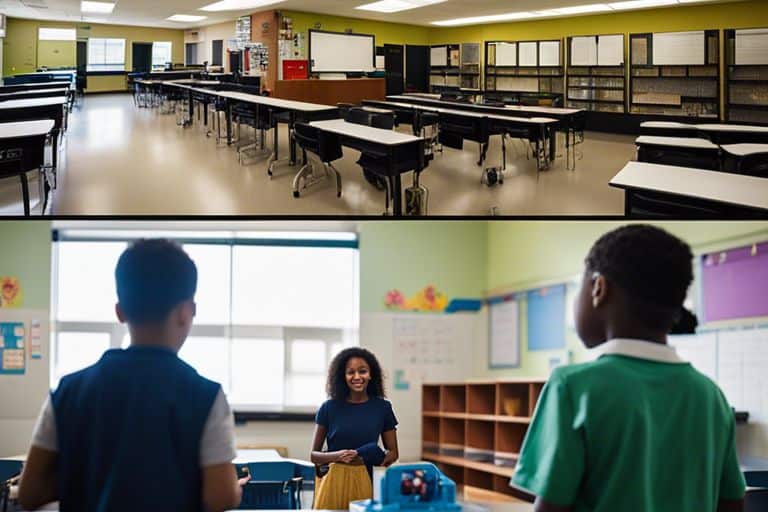Deciding on the best educational setting for a child with special needs can be a complex and daunting task for parents and carers. It is a pivotal decision that can significantly impact a child’s overall development and future prospects. When weighing the options, it is crucial to carefully consider the unique learning requirements, social and emotional needs, and individual strengths of the child. In this blog post, we will explore the key factors to consider when choosing between mainstream and special education, as well as the benefits and potential risks associated with each option. It is essential to make an informed decision that prioritises the well-being and academic success of the child.
Key Takeaways:
- Mainstream schools offer a more inclusive and diverse learning environment, which can benefit students with special needs by promoting social integration and independence.
- Special education schools provide tailored support and resources for students with specific learning disabilities, ensuring a more personalised and adaptive approach to education.
- Individual needs should be the primary factor in choosing between mainstream and special education, carefully considering the unique educational requirements and preferences of the student.

Assessing Your Child’s Needs
Before deciding between mainstream or special education for your child, it is crucial to assess their specific needs. This process involves understanding your child’s learning style and seeking professional evaluations and recommendations. It is essential to gather as much information as possible to make an informed decision about their education.
Understanding Your Child’s Learning Style
Understanding how your child learns best is vital in determining the type of educational environment that will benefit them the most. Observing their behaviour and preferences can provide insight into whether they thrive in a mainstream school setting or would require the additional support offered by special education. Additionally, research on the topic suggests that a thorough understanding of your child’s learning style can lead to more suitable educational placements.
Professional Evaluations and Recommendations
Seeking professional evaluations and recommendations is a crucial step in determining the best educational path for your child. Educational psychologists and specialised professionals can provide valuable insight into your child’s strengths, weaknesses, and learning requirements. Their expertise can guide you towards the most suitable educational setting, as well as provide recommendations for additional support or accommodations.
These evaluations may also involve assessments for specific learning difficulties and disabilities, which can uncover underlying challenges that may impact your child’s education. The information gathered from these assessments is essential in making an informed decision about their educational needs.

Mainstream Education
When it comes to choosing the right school for your child with special educational needs and disabilities (SEND), the decision between mainstream and special education can be difficult. In this blog post, we’ll explore the option of mainstream education and its benefits and challenges. For more information, you can also visit Choosing a mainstream or Specialist school for my child with SEND.
Benefits of Inclusive Classrooms
Mainstream education offers the benefit of inclusive classrooms, where children with SEND are integrated with their peers. This inclusive environment promotes social inclusion and diversity, fostering empathy and understanding among all students. It also provides children with SEND the opportunity to learn alongside their typically developing peers, which can have a positive impact on their academic and social development.
Furthermore, in inclusive classrooms, children with SEND have access to the same educational resources and curriculum as their peers, providing them with equal opportunities to succeed. This inclusive approach can also help break down stereotypes and negative perceptions about disabilities, creating a more accepting and supportive school community.
Challenges in Mainstream Settings
However, despite its benefits, mainstream education also presents challenges for children with SEND. In many cases, teachers may lack the necessary training and resources to support the diverse learning needs of children with SEND. This can lead to difficulties in meeting individual educational requirements, potentially impacting the academic progress and emotional well-being of these students.
Additionally, the emphasis on academic achievement in mainstream settings can create a high-pressure environment for children with SEND, leading to feelings of inadequacy and low self-esteem. The competitive nature of mainstream education may also exacerbate the challenges faced by children with learning difficulties, potentially hindering their overall educational experience.
It’s crucial for parents and educators to carefully consider these challenges and assess whether mainstream education can adequately support the needs of their child with SEND. While inclusive classrooms offer numerous benefits, it’s important to address the existing challenges and work towards creating a truly inclusive and empowering learning environment for all students.
Special Education
Special education refers to the education of students with special needs in a way that addresses their individual differences and needs. This can include students with learning disabilities, physical disabilities, developmental delays, behavioural disorders, and more. The goal of special education is to provide these students with an education that is tailored to their specific needs and abilities, and to help them achieve their full potential.
Tailored Learning Strategies
In a special education setting, tailored learning strategies are designed to meet the specific needs of each individual student. This may involve using alternative teaching methods, assistive technologies, and specialised resources to accommodate the diverse range of learning styles and abilities present in the classroom. By implementing these tailored strategies, students with special needs are given the opportunity to learn and progress at their own pace, in a way that best suits their unique learning requirements.
Considerations for Special Education Environments
When considering special education environments, it is important to take into account the physical and sensory needs of students, as well as the overall classroom environment. This includes ensuring that the classroom is wheelchair accessible, providing necessary accommodations for students with sensory sensitivities, and creating a supportive and inclusive learning environment for all students. It is also important to consider the qualifications and experience of the teaching staff, as well as the availability of support services such as speech therapy, occupational therapy, and counselling.
It is crucial to create an environment where students feel supported, understood, and empowered to reach their full potential. By carefully considering the needs of students with special educational requirements, we can create a positive and enriching learning environment that benefits all students.
Making the Decision
When it comes to choosing the right school for your child, the decision can feel overwhelming. Whether to opt for mainstream education or special education is a significant choice that requires careful consideration.
Factors to Consider
There are several factors that parents should take into account when deciding between mainstream and special education. Educational requirements, social integration, individual support and overall well-being are crucial aspects to consider.
- Assess your child’s specific educational needs and learning style.
- Consider the social environment of both mainstream and special education settings.
- Assess the level of support your child will receive in each setting.
Knowing these factors can help parents weigh up the best options for their child’s education.
Involving Your Child in the Process
It’s essential to involve your child in the decision-making process. Discuss the pros and cons of both mainstream and special education with your child, and consider their preferences and feelings. Empowering your child to be part of the decision-making process can instil confidence and help them realise their worth in the decision.
When involving your child in the decision-making process, emphasise the importance of their input and encourage open communication about their thoughts and feelings. This collaborative approach can lead to a more positive outcome for both the child and the parent.

Choosing the Right School – Mainstream or Special Education?
When it comes to choosing between a mainstream and a specialist school for a child with special educational needs, there are various factors to consider. It is important to thoroughly research and assess the options available, taking into account the individual needs and preferences of the child. It is also crucial to seek guidance and advice from educational professionals and relevant organisations to make an informed decision. The link provided by the National Autistic Society offers comprehensive information and guidance on the topic, assisting parents and carers in making the best choice for their child’s education. Ultimately, the aim is to provide a supportive and nurturing learning environment that enables the child to thrive and reach their full potential.
Choosing between a mainstream and a specialist school
FAQ
Q: What factors should I consider when choosing between mainstream and special education for my child?
A: When choosing between mainstream and special education, it’s important to consider your child’s specific needs, learning style, and potential for academic and social success. It’s also crucial to seek guidance from educational professionals and to research the available options in your area.
Q: What are the benefits of mainstream education?
A: Mainstream education offers the opportunity for children to learn alongside their peers, develop social skills, and access a wider range of academic subjects. It can also provide a more diverse and inclusive environment for students with disabilities or learning differences.
Q: What are the potential drawbacks of mainstream education for children with special needs?
A: While mainstream education can be beneficial for many children, it may not always adequately meet the specific needs of students with disabilities or learning differences. Larger class sizes, limited resources, and a less individualised approach to learning can pose challenges for some students.
Q: What are the benefits of special education?
A: Special education offers a tailored, individualised approach to learning, with specialised support and resources to address specific needs. It provides a supportive environment that can help children with disabilities or learning differences thrive academically and emotionally.
Q: How can I determine which type of education is best for my child?
A: To determine the best type of education for your child, it’s essential to consider their unique strengths, challenges, and educational requirements. Seeking advice from educational professionals, conducting school visits, and gathering information about available support services are all crucial steps in making an informed decision.
Q: What support services are available in mainstream and special education settings?
A: Both mainstream and special education settings offer various support services, such as classroom accommodations, individualised education plans (IEPs), and access to specialised professionals like speech therapists or occupational therapists. It’s important to inquire about the specific support services available at each potential school.
Q: How can I ensure that my child receives a quality education, regardless of the setting?
A: Regardless of the setting, ensuring a quality education for your child involves active communication with teachers, ongoing assessment of your child’s progress, and advocating for their educational needs. Establishing a partnership with the school and staying informed about available resources and services will also contribute to your child’s academic success.







